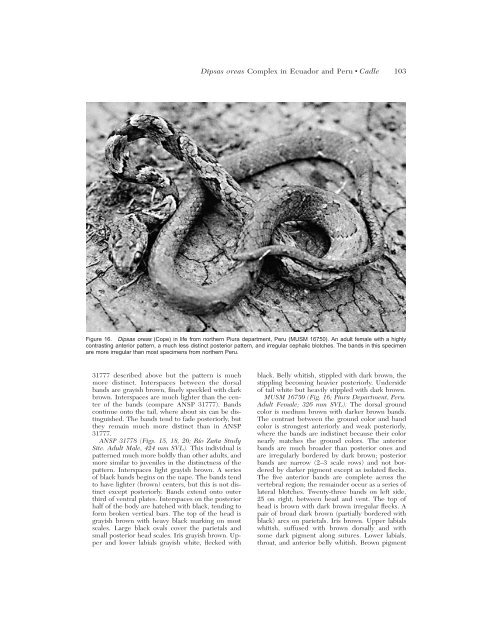systematics of snakes of the dipsas oreas complex - BioOne
systematics of snakes of the dipsas oreas complex - BioOne
systematics of snakes of the dipsas oreas complex - BioOne
Create successful ePaper yourself
Turn your PDF publications into a flip-book with our unique Google optimized e-Paper software.
Dipsas <strong>oreas</strong> Complex in Ecuador and Peru • Cadle 103<br />
Figure 16. Dipsas <strong>oreas</strong> (Cope) in life from nor<strong>the</strong>rn Piura department, Peru (MUSM 16750). An adult female with a highly<br />
contrasting anterior pattern, a much less distinct posterior pattern, and irregular cephalic blotches. The bands in this specimen<br />
are more irregular than most specimens from nor<strong>the</strong>rn Peru.<br />
31777 described above but <strong>the</strong> pattern is much<br />
more distinct. Interspaces between <strong>the</strong> dorsal<br />
bands are grayish brown, finely speckled with dark<br />
brown. Interspaces are much lighter than <strong>the</strong> center<br />
<strong>of</strong> <strong>the</strong> bands (compare ANSP 31777). Bands<br />
continue onto <strong>the</strong> tail, where about six can be distinguished.<br />
The bands tend to fade posteriorly, but<br />
<strong>the</strong>y remain much more distinct than in ANSP<br />
31777.<br />
ANSP 31778 (Figs. 15, 18, 20; Río Zaña Study<br />
Site. Adult Male, 424 mm SVL). This individual is<br />
patterned much more boldly than o<strong>the</strong>r adults, and<br />
more similar to juveniles in <strong>the</strong> distinctness <strong>of</strong> <strong>the</strong><br />
pattern. Interspaces light grayish brown. A series<br />
<strong>of</strong> black bands begins on <strong>the</strong> nape. The bands tend<br />
to have lighter (brown) centers, but this is not distinct<br />
except posteriorly. Bands extend onto outer<br />
third <strong>of</strong> ventral plates. Interspaces on <strong>the</strong> posterior<br />
half <strong>of</strong> <strong>the</strong> body are hatched with black, tending to<br />
form broken vertical bars. The top <strong>of</strong> <strong>the</strong> head is<br />
grayish brown with heavy black marking on most<br />
scales. Large black ovals cover <strong>the</strong> parietals and<br />
small posterior head scales. Iris grayish brown. Upper<br />
and lower labials grayish white, flecked with<br />
black. Belly whitish, stippled with dark brown, <strong>the</strong><br />
stippling becoming heavier posteriorly. Underside<br />
<strong>of</strong> tail white but heavily stippled with dark brown.<br />
MUSM 16750 (Fig. 16; Piura Department, Peru.<br />
Adult Female; 326 mm SVL). The dorsal ground<br />
color is medium brown with darker brown bands.<br />
The contrast between <strong>the</strong> ground color and band<br />
color is strongest anteriorly and weak posteriorly,<br />
where <strong>the</strong> bands are indistinct because <strong>the</strong>ir color<br />
nearly matches <strong>the</strong> ground colors. The anterior<br />
bands are much broader than posterior ones and<br />
are irregularly bordered by dark brown; posterior<br />
bands are narrow (2–3 scale rows) and not bordered<br />
by darker pigment except as isolated flecks.<br />
The five anterior bands are complete across <strong>the</strong><br />
vertebral region; <strong>the</strong> remainder occur as a series <strong>of</strong><br />
lateral blotches. Twenty-three bands on left side,<br />
25 on right, between head and vent. The top <strong>of</strong><br />
head is brown with dark brown irregular flecks. A<br />
pair <strong>of</strong> broad dark brown (partially bordered with<br />
black) arcs on parietals. Iris brown. Upper labials<br />
whitish, suffused with brown dorsally and with<br />
some dark pigment along sutures. Lower labials,<br />
throat, and anterior belly whitish. Brown pigment







